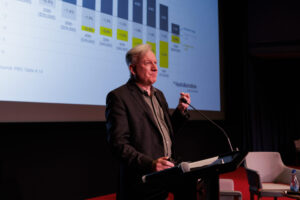A massive tax cut worth $240bn over the next 10 years is set to come into effect in 2024. But this tax cut will not help those who are struggling the most.
It will not help those on low incomes. People earning $45,000 a year or less will get nothing at all. Meanwhile people earning $200,000 a year will get more than $9,000 a year.
These tax cuts were legislated years ago, before the pandemic, and before the inflation crisis. At the time the Coalition was criticised for locking them in long before they knew the state of the economy. These concerns have been realised.
The cost of living crisis changes the game. Let’s track the key moving parts.
Over the past year, inflation has surged, with the cost of essentials rising the fastest – up by 7.6% over the past year, while non-essentials have risen by only 4%.
Many businesses have taken advantage of cost pressures arising from the pandemic, floods, and rising energy costs from the war in Ukraine. They’re increasing prices by more than is needed. So rather than wages driving inflation, it is rising profits that are to blame.
At a time of profit-led inflation, real wages are going backwards at the fastest rate since records began; they have fallen so far that we have lost a decade of real wages growth.
Reducing inflation equitably and easing the cost of living crisis is the key focus of economic policy now. Rather than expanding consumption for the wealthiest, we must urgently reduce costs driving high inflation: energy, childcare, healthcare, education, and housing.
It also means addressing concentrated price-setting power and lifting real wages. The upcoming jobs and skills summit is a prime opportunity to lift worker bargaining power and get the ball rolling.
Whatever the inflation-curtailing policy and whatever the pathway, government need resources to pull this off. And we shouldn’t shy away from redistribution to pay for it.
Economic inequality has exploded under neoliberalism, corrupting politics and tearing at the social fabric. But some people have done very well.
To put things into historic perspective, from the end of the second world war to 1960, the bottom 90% of income earners received almost all the benefits of economic growth. From 1983, the top 10% started growing their share. Shockingly, over the decade to 2019, they pocketed the lot. The bottom 90% received none of the benefits of growth.
The bankrupt economic model that has enriched a minority is the same one that has exposed the majority to privatisation, austerity and wage suppression – all policies multiplying the cost of living crisis for working people today. None of whom benefit from these tax cuts.
Let’s face the facts. The stage three tax cuts are a huge hand out to wealthy men. About half of the cut flows to the top 10% of taxpayers and twice as much goes to men compared to women.
With super profits driving inflation, it makes perfect sense to tax those super profits. They can help clean up the mess.
But retaining our egalitarian traditions like progressive taxation is also important for sharing the load, and building the more cohesive equality-promoting country we need to take on huge economic challenges ahead.
Low-income earners are disproportionately young people and women who face greater financial stress and rely more heavily on public services like Medicare, public schools, and income benefits to build their economic opportunity. Higher earners should pay more tax as part of their duty to these workers and their families.
But if the stage three tax cuts pass, then nurses and CEOs will pay the same marginal tax rate. Our progressive income tax system will have less ability to redistribute income. What kind of society entrenches that sort of social stratification?
In the UK, inflation is expected to exceed 18% next year. Broad social forces are culminating to address the cost of living crisis, emboldened by the National Union of Rail, Maritime and Transport Workers’ industrial campaign on UK’s railways. Their demands include wage rises, price caps on energy bills, 100,000 public houses built each year, and a wealth tax.
Whether Australians unite behind a similar campaign remains to be seen.
What’s clear, though, is that spending $240bn over the next decade in tax cuts for people who aren’t forgoing vegetables and heating will do nothing for the cost of living crisis here.
The stage three tax cuts further weaken our redistribution muscle at the exactly the time we must strengthen it.
Matt Grudnoff is a senior economist at The Australia Institute. Alison Pennington is an economist and writer
Between the Lines Newsletter
The biggest stories and the best analysis from the team at the Australia Institute, delivered to your inbox every fortnight.
You might also like
Stage 3 Better – Revenue Summit 2023
Presented to the Australia Institute’s Revenue Summit 2023, Greg Jericho’s address, “Stage 3 Better” outlines an exciting opportunity for the government to gain electoral ground and deliver better, fairer tax cuts for more Australians.
Richard Denniss: National Press Club Address
On Wednesday, 31 January 2024, Richard Denniss and Allegra Spender MP addressed the National Press Club for a debate on the Stage 3 tax reforms. **Check against delivery** [See below for transcripts] Tax is good. Tax is an investment in our society and the highest taxed countries in the world also happen to be the
Why You’re Paying More Tax Even Though Real Wages Are Shrinking
It’s a bitter irony.



